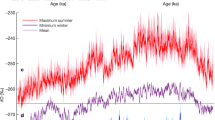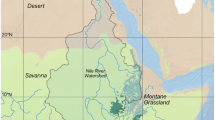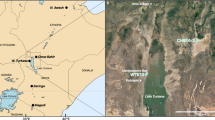Abstract
Arising from T. Laepple, M. Werner & G. Lohmann Nature 471, 91–94 (2011)10.1038/nature09825; Laepple et al. reply
The resemblance of the orbitally filtered isotope signal from the past 340 kyr in Antarctic ice cores to Northern Hemisphere summer insolation intensity has been used to suggest that the northern hemisphere may drive orbital-scale global climate changes1. A recent Letter2 by Laepple et al. suggests that, contrary to this interpretation, this semblance may instead be explained by weighting the orbitally controlled Antarctic seasonal insolation cycle with a static (present-day) estimate of the seasonal cycle of accumulation. We suggest, however, that both time variability in accumulation seasonality and alternative stable seasonality can markedly alter the weighted insolation signal. This indicates that, if the last 340 kyr of Antarctic accumulation has not always looked like the estimate of precipitation and accumulation seasonality made by Laepple et al.2, this particular accumulation weighting explanation of the Antarctic orbital-scale isotopic signal might not be robust.
Similar content being viewed by others
Main
Laepple et al.2 present a range of present-day accumulation and precipitation estimates from a variety of sites across East Antarctica (figure 2a in ref. 2). A broad agreement on the pattern of seasonality suggests a reasonable understanding of the present-day Antarctic precipitation seasonality. Laepple et al. use a geographical mean of these present-day records and an assumption of relatively stable seasonality of precipitation over the past 340 kyr in the calculations. However, Antarctic ice-core evidence suggests that during colder climatic periods, which comprise the majority of the record (Fig. 1b), East Antarctic Plateau precipitation was reduced; during the coldest glacial periods it was probably about half the present-day value3. This observational evidence suggests that changes in precipitation seasonality are possible.
a, Seasonality of accumulation from general circulation model simulations (200 km mean around Dome C site5) and the mean of the Laepple et al.2 East Antarctic Plateau observation set (obs.). Letters on x-axis indicate months of the year (January–December). b, Climatic (left axis) East Antarctic Plateau ice-core records of stable water isotopes (right axis), shown on the EDC3 timescale3. An approach we previously described4 is used to ensure that differences in core sampling do not affect the results. c, The ice-core stable isotope records band-pass filtered between 15 and 50 kyr (right axis). The maximum summer insolation intensity at 65° N (left axis). d, Accumulation-weighted insolation at 77° S, using the four estimates of seasonality shown in a (right axis, same colours as a). The maximum summer insolation intensity at 65° N (left axis). e, Accumulation-weighted insolation at 77° S, using climate-driven (record shown in b) seasonality changes. The accumulation seasonality changes are derived from a linear interpolation of the modelled accumulation seasonality shown in a. The colour scheme indicates whether the interpolated accumulation seasonality reflects a warmer or colder climate. The maximum summer insolation intensity at 65° N (left axis). The lack of agreement between the two lines suggests that allowing the accumulation seasonality to vary with climate can result in a break down in the relationship between weighted insolation at 77° S and maximum summer insolation intensity at 65° N.
Estimates of East Antarctic seasonality across different climates can be obtained using general circulation models. Estimates of Dome C accumulation seasonality from present-day, glacial maximum and warm climate simulations4 are shown in Fig. 1a. The simulation of present-day accumulation amount is accurate5. Relative to the present-day simulation, the cold climate simulation accumulation is approximately halved. This matches ice-core evidence3. The simulated present seasonal accumulation cycle at this site is within the range of the observational uncertainty2.
The different climate simulations show different accumulation seasonality. Using the approach of Laepple et al.2, the impact of these changes in seasonality on the 77° S insolation weighting can be calculated (Fig. 1d). Correlating the 77° S accumulation-weighted insolation values against the 65° N summer intensity (Fig. 1c) yields an R value of 0.63 for the present-day simulation; 0.20 for the glacial simulation; and 0.61 for the warm simulation. This range indicates that the ability of the accumulation weighting to match the 65° N record is dependent on accumulation seasonality. Because the climate for the past 340 kyr has mostly been colder than the present day, it could be more representative to use the cold simulation seasonality. In this case, a relatively small amount of the Antarctic ice-core precession and obliquity signal can be explained by seasonal accumulation weighting of Antarctic insolation.
It is more likely that the precipitation and accumulation seasonality is not stable, and that seasonality varied between different past climates. By interpolating between these three initial model estimates of accumulation seasonality, according to past climate (the isotope record shown in Fig. 1b), seasonality can be allowed to vary directly with climate. Weighting the 77° S local insolation according to this ‘unstable’ seasonality allows a preliminary assessment of the impact of past-climate-driven accumulation changes. The calculation yields a different time series (Fig. 1e, R = −0.25). This result indicates that it is possible that past changes in precipitation (and accumulation) could dominate an accumulation-weighted insolation time series. For this reason some further work, examining the idea that the seasonal precipitation cycle is stable through time, is probably required.
Methods Summary
Long Antarctic stable water isotope records are available for three ice cores1,6,7. These initial climate simulations are run using the HadAM3 atmospheric model. Mean monthly Dome C results are obtained using a 200-km averaging radius5. A colder than present-day simulation is based on observed last glacial maximum sea-surface temperatures8,9. A warmer simulation is based on the Special Report on Emissions Scenarios (SRES) A1B future scenario. Refs 4 and 5 contain further model and simulation details. T. Laepple kindly provided the ‘Laepple’ Fig. 1a mean accumulation observation time series. Thanks also to I. Eisenman and P. Huybers for providing insolation calculation tools. Unstable orbital-sublimation and orbital-precipitation effects could be investigated using a larger set of palaeoclimate snapshot simulations.
References
Kawamura, K. et al. Northern Hemisphere forcing of climatic cycles over the past 360,000 years implied by accurately dated Antarctic ice cores. Nature 448, 912–916 (2007)
Laepple, T., Werner, M. & Lohmann, G. Synchronicity of Antarctic temperatures and local solar insolation on orbital timescales. Nature 471, 91–94 (2011)
Parrenin, F. et al. The EDC3 chronology for the EPICA Dome C ice core. Clim. Past 3, 485–497 (2007)
Sime, L. C., Wolff, E. W., Oliver, K. I. C. & Tindall, J. C. Evidence for warmer interglacials in East Antarctic ice cores. Nature 462, 342–345 (2009)
Sime, L. C. et al. Antarctic isotopic thermometer during a CO2 forced warming event. J. Geophys. Res. 113, D24119 (2008)
Jouzel, J. et al. Orbital and millennial Antarctic climate variability over the last 800,000 years. Science 317, 793–796 (2007)
Petit, J. R. et al. Climate and atmospheric history of the past 420,000 years from the Vostok ice core, Antarctica. Nature 399, 429–436 (1999)
Paul, A. & Schäfer-Neth, C. Gridded Global LGM SST and Salinity Reconstruction. IGBP PAGES/World Data Center for Paleoclimatology, Boulder Data Contribution Series 2003–046 (NOAA/NGDC Paleoclimatology Program, 2003)
Paul, A. & Schäfer-Neth, C. Modeling the water masses of the Atlantic Ocean at the Last Glacial Maximum. Paleoceanography 18, 1058 (2003)
Author information
Authors and Affiliations
Contributions
L.C.S. conducted the original model simulations, carried out the insolation weighting calculations, and co-wrote the manuscript. E.W.W. motivated the work and co-wrote the paper.
Corresponding author
Ethics declarations
Competing interests
Competing financial interests: declared none.
PowerPoint slides
Rights and permissions
About this article
Cite this article
Sime, L., Wolff, E. Antarctic accumulation seasonality. Nature 479, E1–E2 (2011). https://doi.org/10.1038/nature10613
Published:
Issue Date:
DOI: https://doi.org/10.1038/nature10613
This article is cited by
-
Model evidence for a seasonal bias in Antarctic ice cores
Nature Communications (2018)
-
Laepple et al. reply
Nature (2011)
Comments
By submitting a comment you agree to abide by our Terms and Community Guidelines. If you find something abusive or that does not comply with our terms or guidelines please flag it as inappropriate.




